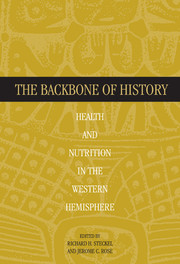Book contents
- Frontmatter
- Contents
- Preface
- List of Contributors
- PART I
- PART II METHODOLOGY
- 2 Reconstructing Health Profiles from Skeletal Remains
- 3 A Health Index from Skeletal Remains
- 4 Paleodemography of the Americas: From Ancient Times to Colonialism and Beyond
- PART III EURO-AMERICANS AND AFRICAN-AMERICANS IN NORTH AMERICA
- PART IV NATIVE AMERICANS IN CENTRAL AMERICA
- PART V NATIVE AMERICANS AND EURO-AMERICANS IN SOUTH AMERICA
- PART VI NATIVE AMERICANS IN NORTH AMERICA
- PART VII
- PART VIII
- PART IX EPILOGUE
- Index
2 - Reconstructing Health Profiles from Skeletal Remains
Published online by Cambridge University Press: 01 March 2010
- Frontmatter
- Contents
- Preface
- List of Contributors
- PART I
- PART II METHODOLOGY
- 2 Reconstructing Health Profiles from Skeletal Remains
- 3 A Health Index from Skeletal Remains
- 4 Paleodemography of the Americas: From Ancient Times to Colonialism and Beyond
- PART III EURO-AMERICANS AND AFRICAN-AMERICANS IN NORTH AMERICA
- PART IV NATIVE AMERICANS IN CENTRAL AMERICA
- PART V NATIVE AMERICANS AND EURO-AMERICANS IN SOUTH AMERICA
- PART VI NATIVE AMERICANS IN NORTH AMERICA
- PART VII
- PART VIII
- PART IX EPILOGUE
- Index
Summary
ABSTRACT
This chapter provides a selective review of nine skeletal and dental lesions that have been used to construct the skeletal database employed in the development of the health index. These lesions are described within a biosocial framework. Change in length of subadult long bones can identify differences in nutrition and health. Linear enamel hypoplasias provide information on the severity and temporal pattern of stress during infancy and childhood. Porotic hyperostosis is a lesion of the skull associated with iron deficiency. Bony responses to bacterial infections are associated with differences in contact with bacteria and the levels of resistance. Patterns of healed fractures indicate activities that include livingon difficult terrain, hazardous occupations, and the extent of warfare and interpersonal violence. Osteoarthritis indicates the degree of regular strenuous activity and quality of life. Dental decay and tooth loss have functional significance for nutritional status.
INTRODUCTION AND PURPOSE
Analyses of skeletal remains are providing a unique window onto patterns of health in past human populations. Until very recently the surviving human tissues, most often bones and teeth (and less often skin, hair, and fluids, such as blood), have usually been ignored in historical and prehistoric research, or at best, their analysis was relegated to appendixes of archaeological site reports (Buikstra, 1991). However, archaeologists and historians have begun to realize that human remains are the most direct means for assessment of past biologies and how these biologies interacted with social, political, and economic processes.
- Type
- Chapter
- Information
- The Backbone of HistoryHealth and Nutrition in the Western Hemisphere, pp. 11 - 60Publisher: Cambridge University PressPrint publication year: 2002
- 98
- Cited by



